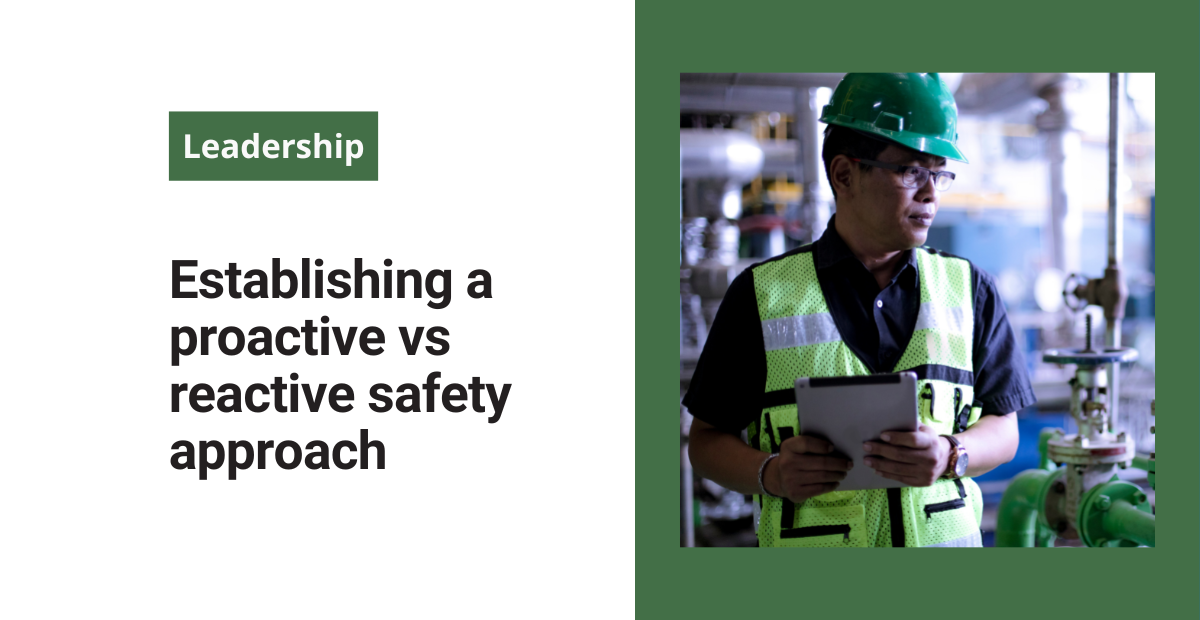In the proactive vs reactive safety discussion, it’s clear that you need both strategies for strong EHS performance. Most safety programs tend to be reactive in nature, meaning that companies handle issues as they arise. But how could you transform your operation if you shifted the focus towards preventative measures, incorporating proactive strategies?
Reactive safety indicators include things like accident investigations, worker’s compensation costs, missed training deadlines, and regulatory citations. Proactive safety indicators include things like workplace safety audits, employee perception surveys, safety training, and near misses.
Below, I’ll discuss the types of safety initiatives and procedures that fall within both approaches. This should give you a better understanding of the differences between the two in terms of proactive safety vs reactive safety strategies.
Components of a reactive safety program
While you need to get ahead of incidents before they happen, you might not always be able to. Below are some of the most common elements of a reactive incident management approach. Make sure you incorporate them into your team’s standard work. They will aid in evaluating proactive vs reactive safety measures.
Accident investigation: The primary purpose for an accident investigation is to
determine the root cause of the accident and use that to information to prevent future
incidents from occurring. It’s essential—you cannot avoid this even if it’s part of a reactive system.
Worker’s compensation costs: Worker’s compensation insurance works in much the same way as any other insurance company. The more incidents a company has, the more the insurance a company must pay. As a result, higher incident rates typically result in higher insurance premiums. This forces consideration between proactive vs reactive safety approaches.
Missed training deadlines: If your company is providing safety training and employees aren’t attending, then that is an indicator of a larger problem within your organization. Not only can it mean that you might be out of compliance with regulatory agencies, but it may also mean that your employees don’t value safety as much as they should.
Regulatory fines and citations: Focusing on dealing with regulatory fines can easily put you in reactive mode. After all, the better approach would be to avoid citations altogether. If you do receive a fine, you can use that as feedback for making changes to your safety program moving forward.
Proactive safety initiatives and procedures
If you want to establish an incident prevention approach, consider implementing these proactive procedures.
Workplace safety audits: Your company should have a designated person (or team) who
Conducts workplace safety audits on a regular basis. They can identify hazards before accidents happen, helping to ensure your compliance with regulatory requirements. This focuses on proactive vs reactive safety tactics.
Employee perception surveys: You need to understand how your employees view safety
and what they know about your safety practices and procedures. This information can be
invaluable when trying to develop a proactive safety program that anticipates issues, differentiating it from a reactive one.
Safety training: Deciding what type of safety training to offer which employees, and on what schedule, can be a daunting task. Regulatory compliance agencies offer some guidance when it
comes to safety training but that should only be your starting point.
Use the data you collect from workplace safety audits, employee perception surveys, and your site’s accident history to develop a training program that best meets your needs.
Near misses: Documenting and investigating near misses can either be categorized as proactive or reactive. Obviously, you don’t want “almost incidents” to happen at all. It’d be better to avoid them altogether.
However, if you take the time to understand why a near miss happened and resolve to fix the variables that contributed to it, you’re taking a proactive approach in the proactive vs reactive safety spectrum.
Using both proactive vs reactive strategies together
The goal is to have a predominantly proactive safety program while maintaining mastery over reactive strategies. One of the best things you can do is to teach your employees hazard recognition and incident prevention strategies during the employment onboarding process. This dual approach helps illustrate the balance of proactive vs reactive safety.
That, in combination with a comprehensive risk management plan, will help create a dynamic safety approach. It balances the preparation of proactive vs. reactive safety strategies effectively.



